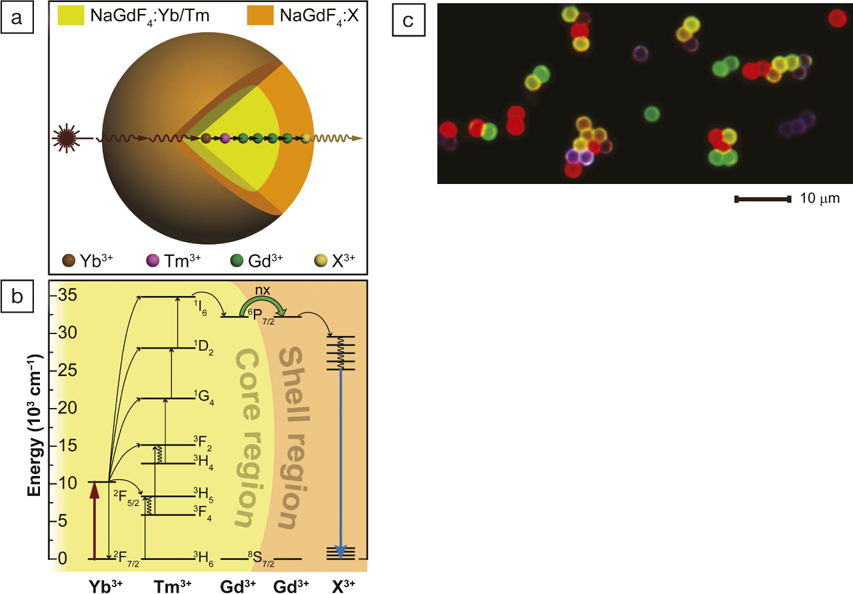Photon upconversion is used to convert long-wavelength sources into short-wavelength emission, and has potential applications in compact solid-state lasers, optical data storage, biological imaging, and solar energy conversion. As reported in the December 2011 issue of Nature Materials (DOI: 10.1038/NMAT3149; p. 968), a team of researchers led by X. Liu from the National University of Singapore, Y. Han from the King Abdullah University of Science and Technology (Saudi Arabia), and X. Chen from the Chinese Academy of Science have developed a system which displays efficient upconversion emission. This was based on photon upconversion in core–shell nanoparticles doped with a series of lanthanide ions. In particular, tunable emission was achieved by controlling gadolinium sublattice-mediated energy migration in NaGdF4 nanoparticles with well-defined core–shell structures.

Tuning upconversion through energy migration in core–shell nanoparticles. (a) Schematic design of a lanthanide-doped NaGdF4@NaGdF4 core–shell nanoparticle for energy migration-mediated upconversion (X: activator ion). (b) Proposed energy transfer mechanisms in the core–shell nanoparticles. (c) Luminescence in core–shell NaGdF4:Yb/Tm@NaGdF4 (blue), NaGdF4:Yb/Tm@NaGdF4:Tb (green), NaGdF4:Yb/Tm@NaGdF4:Eu (red), and NaGdF4:Yb/Tm@NaGdF4:Tb+NaGdF4:Yb/Tm@NaGdF4:Eu (yellow) nanoparticles attached to polystyrene bead. Reproduced with permission from Nature Mater. 10 (12) (2011), DOI: 10.1038/NMAT3149; p. 968. © 2011 Macmillan Publishers Ltd.
The researchers used a sensitizer (Yb3+) that harvests pump photons and subsequently promotes a neighboring accumulator ion (Tm3+) to excited states. This energy is then transferred to a migrator (Gd3+) from high-lying energy states of the accumulator, and finally, by random energy hopping through the migratory ion sublattice and trapping of the migrating energy by an activation ion (Tb3+, Eu3+, Dy3+, and Sm3+). Importantly, the researchers achieved efficient upconversion emission at room temperature and moderate excitation densities. To regulate the energy exchange interaction between the accumulator and the activator, the researchers confined the sensitizer and the accumulator in the core level of the nanoparticles, while the activator was confined in the shell. The presence of Gd3+ in both core and shell levels created an array of migratory ions that bridged the energy transfer from the accumulator to the activator.
Additional experiments were also performed which revealed that confinement of the sensitizer, accumulator, and activator in the same layer quenched the upconversion emissions, therefore demonstrating the necessity of the core–shell structures. It was also found that Gd3+ was crucial for this energy transfer and that the luminescence could be varied according to the Gd3+-Gd3+ interionic distance. The researchers additionally observed that the excitation energy could travel long distances through the Gd3+ sublattice, which allowed design interparticle energy migration transfer to lanthanide-doped inorganic nanoparticle acceptors.
This work was used to demonstrate different phenomena including upconversion emissions that cover almost the entire visible spectral range, simultaneous excitation of two different dyes by conventional Förster resonance energy transfer, and tunable upconversion emissions. The ability to tune upconversion properties by combining energy migration and core–shell structural engineering could expand the range of applications for lanthanide-doped nanoparticles, and may stimulate the development of lanthanide-based luminescent materials.


